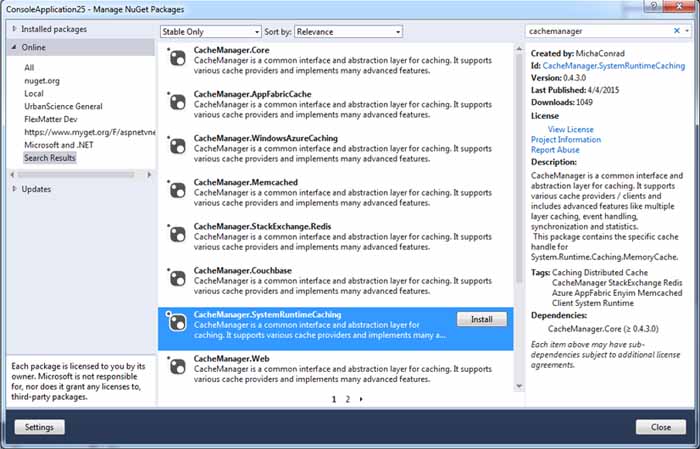The Basicslink
Cache Manager is structured into many different Nuget packages. The one which is common but must not be installed stand alone is CacheManager.Core. All other packages will add functionality, cache handles and other features, which are totally optional.
To get more details about the Cache Manager packages and features, read the readme file and the features article.
But now let's get started...
New Console Applicationlink
To get started let us create a new .Net C# console application in visual studio:

Now right click the project in solution explorer and click "Manage Nuget Packages", put "cachemanger" into the search box on the top right, you should get a list of packages like this:

Select the "CacheManager.SystemRuntimeCaching" package and hit "Install".
This will actually install already all you need to use cache manager with the System.Runtime.Caching based in-process cache.
Now let's add some code to the newly created program.cs Main method:
using System;
using CacheManager.Core;
namespace ConsoleApplication
{
class Program
{
static void Main(string[] args)
{
var cache = CacheFactory.Build("getStartedCache", settings =>
{
settings.WithSystemRuntimeCacheHandle("handleName");
});
}
}
}
This will create a new Cache Manager instance. To use the instance, we can add some test code. We will add two items, updated the second and then read both keys.
cache.Add("keyA", "valueA");
cache.Put("keyB", 23);
cache.Update("keyB", v => 42);
Let's also remove one key and see if it worked... The full code example:
static void Main(string[] args)
{
var cache = CacheFactory.Build("getStartedCache", settings =>
{
settings.WithSystemRuntimeCacheHandle("handleName");
});
cache.Add("keyA", "valueA");
cache.Put("keyB", 23);
cache.Update("keyB", v => 42);
Console.WriteLine("KeyA is " + cache.Get("keyA")); // should be valueA
Console.WriteLine("KeyB is " + cache.Get("keyB")); // should be 42
cache.Remove("keyA");
Console.WriteLine("KeyA removed? " + (cache.Get("keyA") == null).ToString());
Console.WriteLine("We are done...");
Console.ReadKey();
}
Hopefully this worked out just fine. Now you should be set to play around with the Cache Manager!